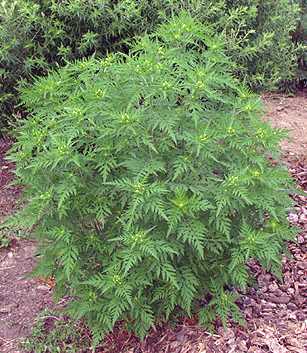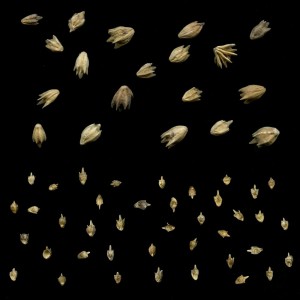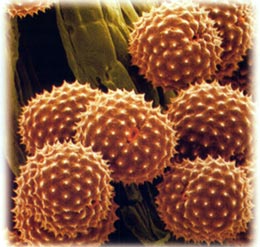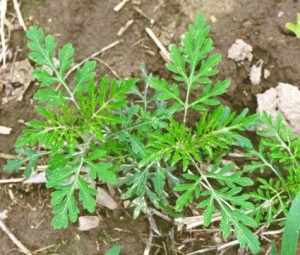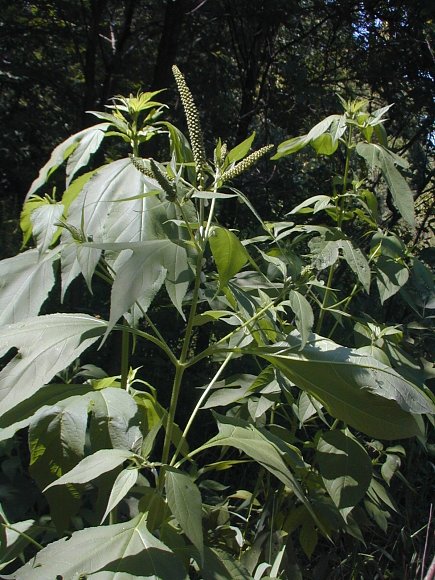
Some 18 generations ago — 600 years ago give or take a century or two — some Natives Americans stopped cultivating a particular crop and may have moved on to maize. About 150 years ago — five generations — American farmers were raising crabgrass for grain when they, too, moved on to corn, the descendant of maize. So what crop did the Indians stop growing? Ragweed, the most hay-fever causing plant in the world. No one alive knows why Ragweed fell out of cultivation though the development of maize is a prime guess. And Ragweed certainly is not favored by farmers now who view it as a vile invader that chokes domestic crops. Perhaps it’s time to reconsider Ragweed.
The grain is some 47% crude protein and 38% crude fat. That’s an energy powerhouse despite the size. The seed oil is edible and at least one person alive today has eaten a small hand full of seeds. They taste like wheat bran. In excess of 5,000 seeds can be produce per plant. Generally said Ragweed is not an “antique vegetable” as such things are sometime called. But, it might be a lost grain. Ragweed oil is on par with soybean oil and the plant produces about the same amount as soybean, one fifth the seed weight. Some reports say natives would grind the seeds, bring them to boil in water, the oil would float to the top, then was ladled off.
While one could argue this is much to do over some oil but fat is essential to survival. You absolutely cannot live without some source of fat. Oil would have been extremely important to native populations and could be again if we were ever forced to provide our own food. And unlike soybean which has to be cultivated, Ragweed is a weed that can do all right on its own. One debate in the ethnobotanical community is whether the natives cultivated a huge version of Giant Ragweed or not. One study says yes because the seeds that were found were larger than found in nature. Another study says no reporting that there are large seeds in nature as well. Bit of a toss up there. But we know animals certainly ate them and still do. In fact Ragweed is one of the few seed-bearing plants that stands above deep snow providing valuable creature food during the winter. It’s on the menu for the Eastern Cottontail, Meadow Vole, grasshoppers which eat the leaves, Dark-eyed Junco, Brown-headed Cowbird, Northern Bobwhite, Purple Finch, Mourning Dove, American Goldfinch, and the Red-bellied Woodpecker. Sheep and horses also like to eat the plant. What about humans eating the hard seeds or foliage? There’s a lot of speculation but few hard facts.
An article on the plant at Michigan State University for the W.J.Beal Botanical Garden says: “…some archaeologists have suggested that … the seeds were impractical as a food source. However, the fact that Indigenous Americans were specialists at navigating starvation episodes, combined with the observation that giant ragweed seeds are comprised of about 19 percent edible oil, make it fairly certain that these seeds would not be overlooked as a food resource.” No details given. A weed ecology fact sheet for Ohio State University says: “One of our few native weeds. Seeds eaten by pre-Columbian Indians.” Again, no details. In the book Archaic Societies: Diversity and Complexity Across the Midcontinent by Thomas E. Edison (2009) it mentions a 1997 it report (Gremillion) that Ragweed seeds were found in paleofecal material from 950 to 1400 years ago along with sunflower seeds and sumpweed seeds. It’s difficult for a seed to end up in an ancient bathroom unless it was eaten. In 1984 Peter Goodchild published Survival Skills of the North American Indians. On page 209 in a list of “food plants” he writes for the Giant Ragweed “cultivated for its seed in several areas.“
Was Giant Ragweed cultivated? It would seem so, and for its grain. It’s definitely in the ancient farmers crop line up but then falls away. The next question is was it raised to eat the grain or for the oil, or both? It’s not easy in modern times to be aware of past practices. For example, some suggest the natives crush the seeds and boiled them for oil (not unlike acorns.) Possible yes, but is it probable this was done for food? In communication with Goodchild he writes:
“Judging from other uses of oily seeds, the natives are unlikely to have done any processing of the seeds. Generally that’s not practical without modern machinery. I’ve even experimented myself with sunflower seeds, and found no practical (primitive) method of getting the oil out — it’s far easier just to eat the seeds”

Thus while the seeds have oil its extraction might not have been the prime use whereas eating the grain could have been. But might I offer a variant of that? From a calories-in calories-out point of view — or level of difficulty — many ancient foods would not be consumed. They just were not worth the effort as food. Among them could be smilax root starch and pokeweed greens. Getting the starch out of a smilax root is a Herculean task that burns far more calories than is produced on consumption. And boiling pokeweed twice does not make caloric sense when boiling was difficult and other nutritious leaves could be eaten raw. What I suspect was whilst in the pursuit of medicine — which is not a calories-in calories-out dependent task — it was discovered various plants had other edible parts. Medicinal needs could justify calorie-deficit tasks. And while fat was obtainable from animals a plant oil might have its medicinal applications. So perhaps the Giant Ragweed could have been used for food and for oil but the latter in a medicinal sense. Ragweed oil might have been too valuable to eat but worth the effort to obtain medicinally. Another possible aspect professional archaeologists never seem to consider is that long ago the menu changed only with the seasons. They would dismiss Giant Ragweed grains as too small or not worth the effort to make a stable crop, and that may be true. But, such grains were another flavor and texture to add to the limited, slow-to-change diet. We sprinkle pine nuts on pesto. Might they have done something similar?
As for allergens, Ragweed is second only to mold in causing allergic symptoms. There are 17 species of Ragweed in North America. The common ragweed (Ambrosia artemisiifolia) can produce a million grains of pollen per plant daily, the Giant Ragweed (Ambrosia trifida) can create in excess of 1.25 million grains daily and over a billion during its life cycle. This leads to a lot of cross pollination and plant variation. Left on its own Ragweed is a riparian plant living along rivers and local flood plains. Isolated patches depend upon the wind to carry the pollen. With the migration of man so went the Ragweed and the number of plants and the amount of pollen carried by the wind. Ragweed has multiple antigens but the strongest is Antigen E. There are also several plants that in the greater Ragweed family that can cause allergic reactions including sage brush, marsh elders, poverty weed, cocklebur, desert broom, groundsel bush, feverfew and dog fennel. Goldenrod is unfairly blamed for causing allergies because it blooms at the same time as Ragweed. But, its pollen is too heavy to be windblown. (Here’s a botanical hint: Green flowers, in particular small green flowers, are usually wind-pollinated. They aren’t colorful enugh to attract insects for pollination.)
There is also at least one Ragweed with a root the natives ate, Ambrosia tenuifolia, Slimleaf Burr Ragweed. Professor Daniel Moerman reports the Papago Indians dried the roots in the sun and used them as a staple crop (that would be in Arizona.) They also ate the stalks as greens. However the USDA lists Ambrosia tenuifolia as only growing in Louisiana and Puerto Rico. That particular Ragweed it is native to South America and has been naturalized in Spain, France and Italy. Why it is missing from Arizona now is anyone’s guess. Elsewhere natives used Ragweed stalks for rope. The stems and leaves of Ambrosia peruviana were and are used as a green dye. Various species were also used medicinally, see Herb Blurb below.
As for the binomial name, Ambrosia is usually translated into English as meaning “food of the gods.” A direct translation from the Greek means “unmortal” or “not mortal.” In Greek mythology “ambrosia” was sometimes the food the gods ate and or wine they drank which gave the gods (and demigods) immortality thus called “ambrosia.” But, food and drink were used interchangeably thus for some ancient writers “ambrosia” was food and for others it was drink which was also called nectar, Greek NEKtar which means “death overcoming.” Ambrosia is close to the older Sanskrit word Amrita which means “without death.” Clearly there was a long-running theme here. Greek gods, who always had human failings and consequently were far from perfect, were what they ate and drank, not unlike people today. Why a rather nondescript plant that is a prime allergen would be called Ambrosia is anyone’s guess. No hints were left.
A couple of more things: The common ragweed, Ambrosia artemisiifolia, is the most efficient plant to remove lead from the ground. And I know a retired doctor in south Florida who tells me he’s eating Ragweed, Ambrosia artemisiifolia. Like Pokeweed he is boiling it twice in this case to moderate the flavor. We know from his experiment this apparently does not cause any acute toxicity or quick reactions. However, a steady diet of Ragweed might cause issues over the long term, or might not. We just don’t know.
Green Deane’s Itemized Plant Profile: Giant Ragweed
IDENTIFICATION: Annual 3 to 12 feet tall, branching occasionally. Green stems covered with white hairs, leaves opposite to a foot long and eight inches wide, larger leaves divided into 3 or 5 lobes, usually serrated along the edge, long petioles sometimes winged. Smaller leaves near the base of flower lance-shaped, often hairy underneath. Upper stems terminate in a cylindrical flower spike to six inches long. Small flowers yellowish green, no petals or sepals, drooping clusters.
TIME OF YEAR: Flowers late summer or early fall, seeds follow, large, tough-coated, viable for many years.
ENVIRONEMENT: Full sun to light shade, moist, fertile soil. It is native to 47 of the 50 states missing Nevada, Hawaii, and Alaska.
METHOD OF PREPARATION: We have no idea. Perhaps ground seeds boiled in water, oil skimmed off the top. Perhaps the seeds were parched then eaten. A few can be eaten raw. Beyond that there is no modern report of consumption other than the doctor I mentioned above.
Herb Blurb
Te genus yields volatile oils. quercetin, and bitter alkaloids. Plant extracts are anti-bacterial and anti-viral. Ambrosia ambrosioides; a tea was made from the roots and given to women after birth. Ambrosia confertiflora; used to cure diarrhea, flowerettes chewed and followed by a drink of water. Ambrosia cumanensis; herb teas for yellow fever, constipation, menorrhagia. Herb juice for pleurisy. Root or herb infusions for colds, flu, fever, in postpartum depurants. Herb of second growth crushed leaves mixed with chicken fat and/or hot water, cool mixture rubbed on the body to reduce fever. Ambrosia elatior as a poultice. Ambrosia hispida was used to relieve fever, stomach ache, pain, loss of appetite, and flu. To boiled leaf tea they added salt to to increase the appetite then drank the tea for nine mornings. Lemon juice and salt was added when it was used for gas and colds. A weak leaf tea with salt was used to relieve menstrual pain (again taken for nine mornings.) It was also a “granny” medicine to “clean everything out” after childbirth. Tea from fresh plant less better than tea from dried plant. Ambrosia psilostachya, a bitter decoction taken to relieve fever.
Journal of Northeast Forestry University 2008-01
GC-MS Analysis of Fatty Acid Constituents in Ambrosia trifida Seed Oil
Zhang Lin,Yang Lei,Niu Huiying,Li Xiaowei,Zu Yuangang(Key Laboratory of Forest Plant Ecology of Ministry of Education,Northeast Forestry University,Harbin 150040,P.R China)
Seed oil extracted from the seeds of Ambrosia trifida through solvent extraction was analysed by GC-MS after esterification. Four components from six peaks of the fatty acid constituents were identified.The main constituents are linoleic acid and oleic acid,and the relative contents are 81.60% and 14.73%,respectively.

